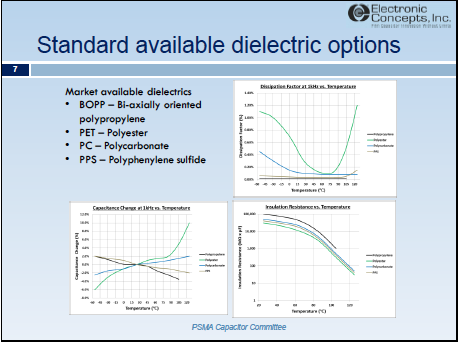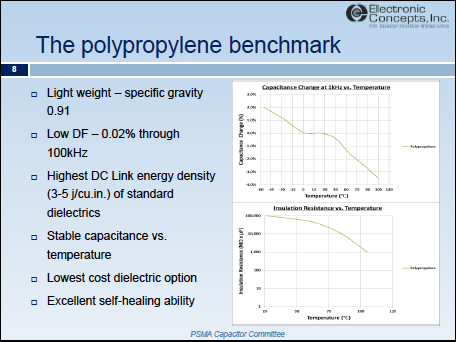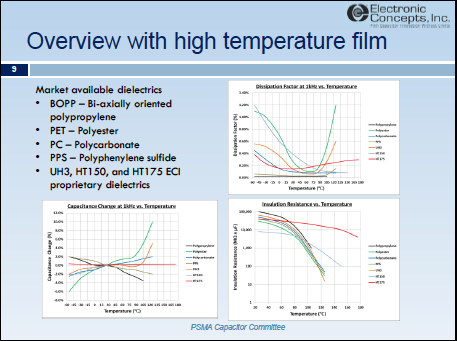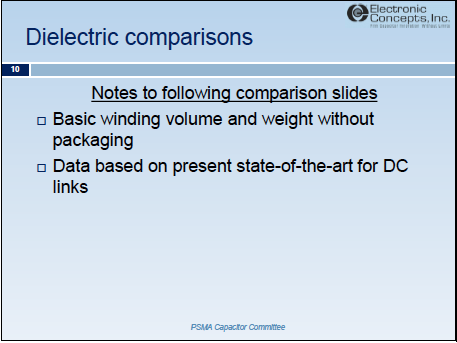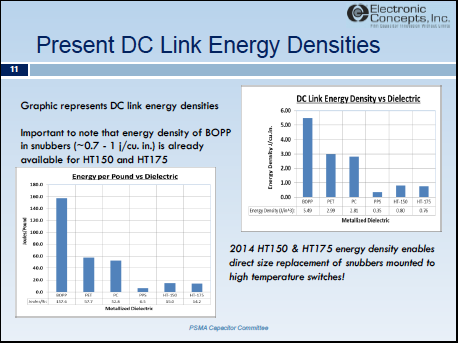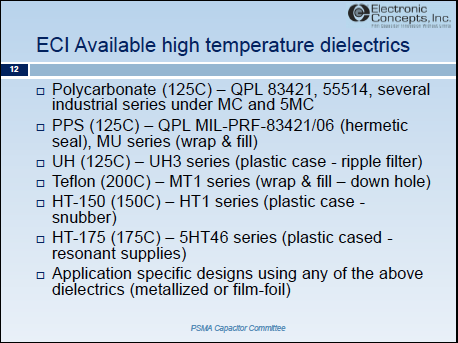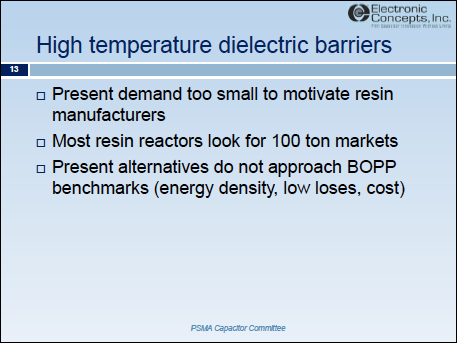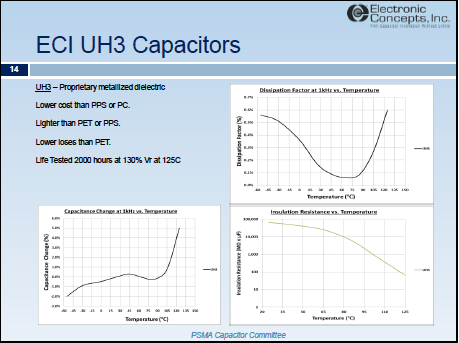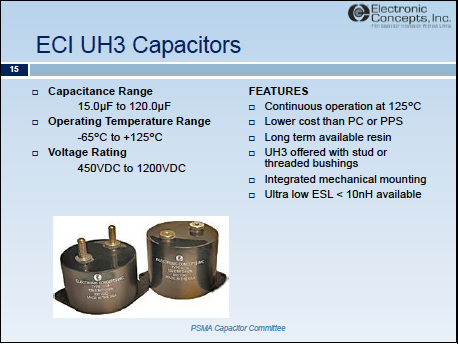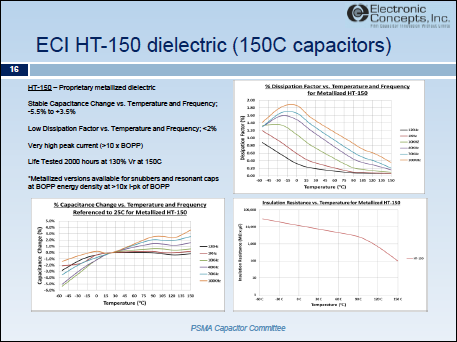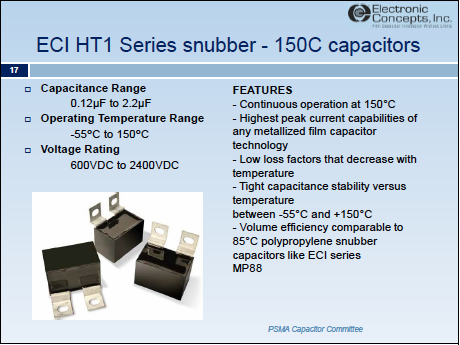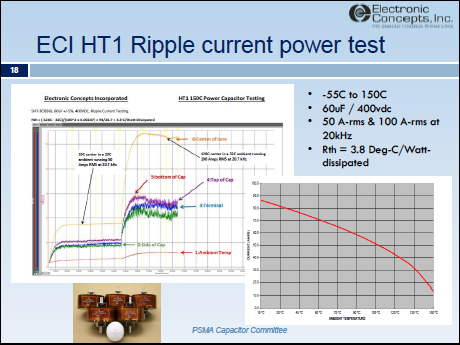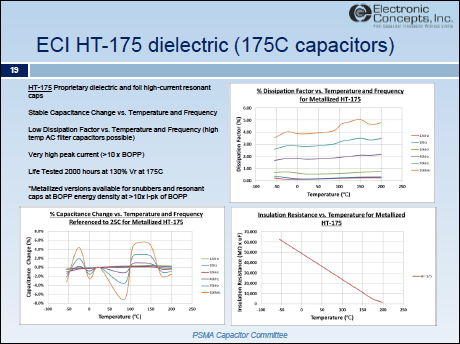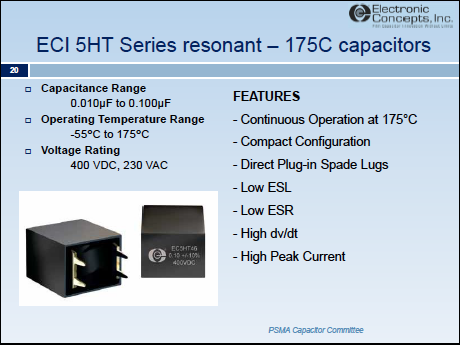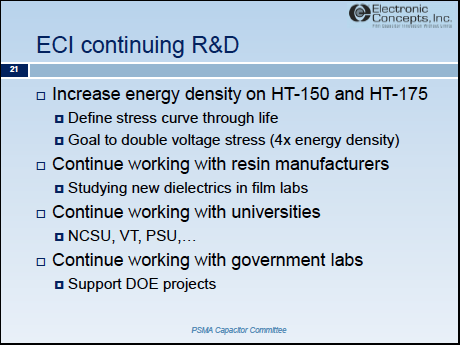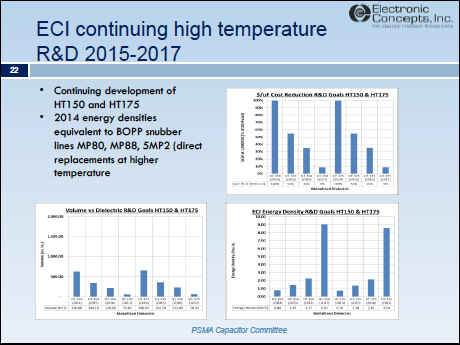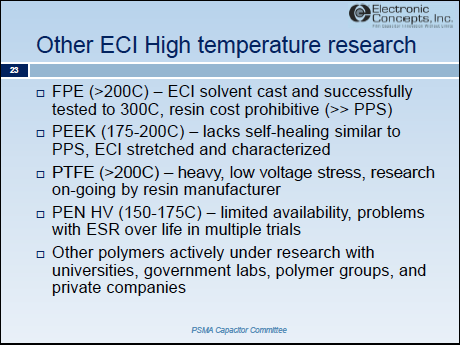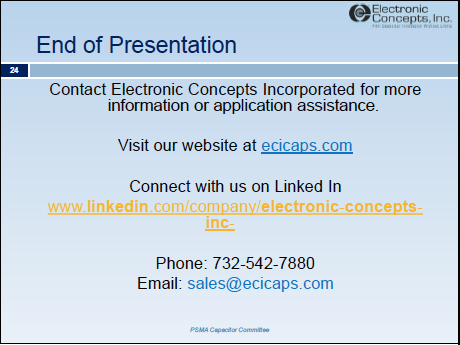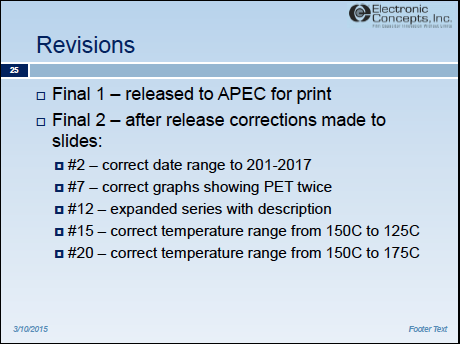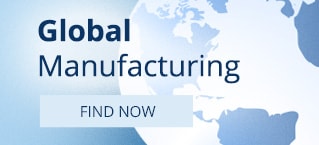Home > Tech Tools > Technical Papers > ECI High Temperature Film Capacitors
- Electronic Concepts Inc. is an industry leading plastic film capacitor manufacturer incorporated in 1969.
- Primary markets served include military, medical, aerospace, alternative energy, traction, and industrial power conversion.
- Global corporation with design and manufacturing in America and Europe.
- Vertically integrated with:
- Solvent casting plant producing polymers including polycarbonate and proprietary dielectrics.
- Full machining capabilities including CNC machining centers, CNC screw machines, punch presses, and other equipment to produce terminals, housings, buss bars, laminates, tooling and production machines.
- In-house film metallizing and converting capabilities.
- Full qualification capabilities including environmental and electrical testing and qualification.
- R&D for materials and capacitors for corporate objectives, universities, industries, and government labs.
This presentation is an overview of ECI dielectric research and industry available dielectrics.
Benchmarking to bi-axially oriented polypropylene (BOPP) is discussed.
“January 15, 2015 President Obama announced that North Carolina State University will lead the Energy Department’s new manufacturing innovation institute for the next generation of power electronics. The institute will work to drive down the costs of and build America’s manufacturing leadership in wide bandgap (WBG) semiconductor-based power electronics — leading to more affordable products for businesses and consumers, billions of dollars in energy savings and high-quality U.S. manufacturing jobs.” (Source: http://energy.gov/articles/wide-bandgap-semiconductors-essential-our-technology-future)
(Source: NCSU Site reference: http://www.ncsu.edu/power/)
According to the Department of Energy article, “Wide Bandgap Semiconductors: Pursuing the Promise”
WBG Electronic devices:
- Reduced energy losses: Eliminates up to 90% of the power losses that currently occur during AC-to-DC and DC-to-AC electricity conversion.
- Higher-voltage operation: Handles voltages more than 10 times higher than Si-based devices, greatly enhancing performance in high-power applications.
- Higher-temperature operation: Operates at temperatures over 300°C (twice the maximum temperature of Si-based devices). This tolerance for higher operating temperature results in better overall system reliability, enables smaller and lighter systems with reduced lifecycle energy use, and creates opportunities for new applications.
- Higher frequencies: Operates at frequencies at least 10 times higher than Si-based devices, making possible more compact, less costly product designs and opening up a range of new applications, such as radio frequency (RF) amplifiers.
- Improved power quality: Ensures more reliable and consistent power electronic device operation.
(Source: http://energy.gov/articles/wide-bandgap-semiconductors-essential-our-technology-future)
The Department of Energy (DOE) objectives for traction inverters are reducing cost and increasing efficiency.
High temperature electronics eliminate the separate cooling system and devices operate off engine coolant.
Latent heat specifications project that on shutdown the temperature could rise to 140C.
DOE incentives to use wide bandgap semiconductors (WBG) intend to increase switch frequency and decrease capacitor and inductor size and weight.
Energy density goals for high temperature capacitors far exceeds the state-of-the-art for 85C BOPP DC Links.
Present BOPP energy density DC links ~5 j/cu.in. (~0.31 j/cc) does not meet DOE goal of 65.6 j/cu.in (4 j/cc)
Present BOPP DC links for traction inverters typically range 500-1000uF and 450 – 1200vdc with typical switch frequencies of 2-5kHz producing ripple currents 200 – 500 amps-rms
Because of the higher cost of high temperature dielectrics the best opportunity for film caps is high frequency WBG switches to drive capacitance required down (10x ripple frequency = 1/10 capacitance for same Z).
(Source: Susan Rogers, APEEM R&D Vehicle Technologies Program, “Electric Drive Status and Challenges”, Slides 2-3)
Industry standard dielectrics available to capacitor manufacturers.
BOPP dominates the power capacitor market, and is the benchmark new polymers are compared against.
Polycarbonate is presently not available for new designs.
ECI is the last global producer of high molecular weight solvent cast polycarbonate for capacitor dielectric. Finite resin supply. We continue to look for new sources of the proper resin grade needed to continue production viable for new design.
Standard metallized bi-axially oriented polypropylene (BOPP).
BOPP is the dominant dielectric for power capacitors.
Energy density, low losses, self-healing, and low cost set a high standard for comparison to high temperature dielectrics.
ECI high temperature HT150 and HT175 referenced to standard industry dielectrics.
Capacitance stability versus temperature for HT150 and HT175 better than BOPP.
High temperature insulation resistance for HT150 and HT175 better than BOPP over 100C.
High temperature dissipation factor for HT150 and HT175 provides low ESR in DC Link banks.
Data used in graphics based on unpackaged capacitor windings.
Data derived based on design comparison of 1000uF/1000vdc design varied by dielectric and present (2014) design stresses for each dielectric.
Energy comparison of dielectrics including ECI proprietary HT150 and HT175 at 2014 design levels.
HT150 and HT175 already qualified to stress levels equivalent to many market available BOPP snubbers enabling direct size replacements for many snubber and resonant capacitors at higher temperature ratings.
HT150 and HT175 qualifications at maximum temperature translate to high reliability at lower temperatures.
PC produced by ECI film division but not recommended for new designs due to finite resin availability.
PPS limited availability by Toray’s production schedule.
Teflon (PTFE) energy density low, heavy, and expensive.
UH lower cost 125C alternative to PPS or PC.
HT-150 and HT-175 produced by ECI film division.
Many lab scale polymers actively being studied but most do not realize commercialization.
Although market demand is growing for high temperature capacitor dielectric, it is still a fraction of what resin manufacturers want to react new polymers.
A common problem facing many new high temperature dielectrics is the extreme price compared to the BOPP benchmark. Combined with lower energy densities and higher losses, the products require larger volume and higher dielectric content exaggerating the cost in comparison to BOPP.
UH3 series
Lower cost than polycarbonate or PPS.
Values recorded from metallized UH3 capacitors.
As with all ECI technologies, available for application specific designs.
Metallized UH3 proprietary dielectric capacitors.
Lower cost than polycarbonate or PPS with 125C operation.
Convenient building block units with integrated mountings.
HT-150
Values recorded from metallized HT-150 capacitors.
Tight capacitance stability.
DF decreases with temperature.
Life testing at 130% rated voltage at 150C produces very high life projections at 100-120C and typical application voltage of 70% rated voltage.
Further testing planned to define higher energy density gradient at 105C – 125C
HT-150 proprietary metallized dielectric.
Other values and voltages on request.
Snubber caps (HT1 series) have the same energy density as standard BOPP snubbers.
Peak current tested >1M pulses at >30x BOPP breakdown with no change at 25C
Peak current tested >500K pulses at >30x BOPP breakdown with no change at 150C
Design retrofits available for ECI snubber lines 5MP2, MP80, MP88, and PT88.
Design retrofits available for ECI DC ripple filtering line UH3.
HT-150 metallized dielectric.
20kHz ripple current with thermocouples in capacitor center data logged relative to terminals and outer surfaces of capacitor.
A typical 500uF/400vdc (~ 8 x 60uF shown) DC link bank capable of 400 amps at 105C and 240 amps at 125C.
HT-175
Values recorded from metallized HT-175 capacitors.
Characterized to 200C.
For DC biased ripple filtering ESR is the heating factor. A 10x increase in DF results in a 2.5x ESR. Thus capacitance values > 100uf see very little effect of the higher frequency DF due to the low reactance.
Further testing planned to define higher energy density gradient at 105C – 150C
HT-175 proprietary dielectric and foil.
Low capacitance values with extremely high peak currents for high frequency applications like resonant supplies.
Other values and voltages on request.
Metallized versions also available for snubber caps with the same energy density as standard BOPP snubbers.
Peak current tested >1M pulses at >30x BOPP breakdown with no change at 25C
Peak current tested >500K pulses at >30x BOPP breakdown with no change at 175C
Retrofits ECI snubber lines 5MP2, MP80, MP88, and PT88.
Design retrofits available for ECI DC ripple filtering line UH3.
HT150 and HT175 both tested and characterized for life at max temperature (150C and 175C respectively) and 130% rated voltage.
Further testing planned to study higher voltage stresses at 105C, 125C, and 140C.
Further advancements in film production and electrode design under study to increase energy density.
Presently working with other polymers in partnerships with many institutions.
ECI R&D goals for 150C and 175C increases in energy density, and reductions in volume and cost.
Look to partner with WBG users for direct-to-switch mounted high temperature snubbers.
- HT150 and HT175 already qualified for replacing BOPP snubbers in equivalent energy densities.
- Peak current capabilities of HT150 and HT175 are rated 10x higher than equivalent sized BOPP snubbers.
Some other materials studied and characterized for capacitor dielectrics but not actively designed in DC links for reasons shown.
Although many high temperature dielectrics are discussed in conferences and technical bulletins, most are not commercially available for production.
ECI materials research pursues two avenues of studies:
- Market available materials serving other applications to provide sustained availability not driven by dielectric applications.
- New polymers at lab scales evaluated in partnership with external organizations for future development.
Visit our website for further information on available standard product series.
ECI specializes in designing application specific products – please contact us to discuss your particular requirement.
Connect and follow us on Linked In for latest product announcements and discussions.







